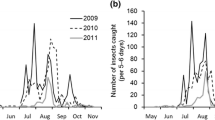Abstract
Nocturnal insects show phototactic behavior. Interestingly, males are caught by light traps more often than females in many species. In the present study, the male-biased capture in light traps in the field was evaluated to test the hypothesis that male-biased capture was associated with the reproductive activities of Spodoptera exigua. During a 16-wk. period in 2011, a total of 5075 moths caught by light traps in the field revealed a significant male-biased capture. However, the sex ratio of the natural population was not significantly different from 1:1 from July to October 2011. The ratio of moths caught per hour by light traps showed that females were captured in the first half of the night, whereas the peak capture by light traps for males occurred in the second half of the night. Among the captured adults, the percentage of unmated females was significantly lower than that of the mated females and males. Experiments in the laboratory indicated that the time of activities for both sexes was consistent with the active patterns of oviposition and copulation. The percentage of flight-to-light of the unmated females was significantly lower than that of the mated females and males. Thus, the lower capture of the unmated females, which is associated with reduced positive phototactic responses of S. exigua, probably is one of the reasons resulting in the male-biased sex ratio in light traps.




Similar content being viewed by others
References
Altermatt F, Baumeyer A, Ebert D (2009) Experimental evidence for male biased flight-to-light behavior in two moth species. Entomol Exp Appl 130:259–265
Andersson M (1994) Sexual selection. Princeton University Press, Princeton
Azidah AA, Sofian-Azirun M (2006) Life history of Spodoptera exigua (Lepidoptera: Noctuidae) on various host plants. B Entomol Res 96:613–618
Baker GH, Tann CR, Fitt GP (2011) A tale of two trapping methods: Helicoverpa spp. (Lepidoptera: Noctuidae) in pheromone and light traps in Australian cotton production systems. B Entomol Res 101:9–23
Banerjee AC (1967) Flight activity of the sexes of crambid moths as indicated by light-trap catches. J Econ Entomol 60:383–390
Beck J, Linsenmair KE (2006) Feasibility of light-trapping in community research on moths: attraction radius of light, completeness of samples, nightly flight times and seasonality of southeast-Asian hawkmoths (Lepidoptera: Sphingidae). J Res Lepidoptera 39:18–36
Cheng WJ, Zheng XL, Wang P, Lei CL, Wang XP (2011) Sexual difference of insect phototactic behavior and related affecting factors. Chin J Appl Ecol 22:3351–3357
Delisle J, West RJ, Bowers WW (1998) The relative performance of pheromone and light traps in monitoring the seasonal activity of both sexes of the eastern hemlock looper, Lambdina fiscellaria fiscellaria. Entomol Exp Appl 89:87–98
Dong SL, Du JW (2001) Diel rhythms of calling behavior and sex pheromone production of beet armyworm, Spodoptera exigua (Lepidoptera: Noctuidae). Instr Sci 8:89–96
Garris HW, Snyder JA (2010) Sex-specific attraction of moth species to ultraviolet light traps. Southeast Nat 9:427–434
Holyoak M, Jarosik V, Novák I (1997) Weather-induced changes in moth activity bias measurement of long-term population dynamics from light trap samples. Entomologia Experimentalis et Applicata 83:329–335
Kalmus H, Smith CAB (1960) Evolutionary origin of sexual differentiation and the sex-ratio. Nature 186:1004–1006
Leppla NC, Hamilton EW, Guy RH, Lee FL (1979) Circadian rhythms of locomotion in six noctuid species. Ann Entomol Soc Am 72:209–215
Oh MS, Lee CH, Lee SG, Lee HS (2011) Evaluation of high power light emitting diodes (HPLEDs) as potential attractants for adult Spodoptera exigua Hübner (Lepidoptera: Noctuidae). J Korean Soc Appl Bi 54:416–422
Rhainds M (2013) Field assessment of female mating success based on the presence–absence of spermatophore: a case study with spruce budworm, Choristoneura fumiferana. Ann Zool Fenn 50:377–384
Rhainds M, Heard SB (2015) Sampling procedures and adult sex ratios in spruce budworm. Entomol Exp Appl 154:91–101
Saito O (2000) Flight activity of three Spodoptera spp., Spodoptera litura, S. exigua and S. depravata, measured by flight actograph. Physiol Entomol 25:112–119
Shimoda M, Honda K (2013) Insect reactions to light and its applications to pest management. Appl Entomol Zool 48:413–421
Shorey HH, Gaston LK (1965) Sex pheromones of noctuid moths. V. Circadian rhythm of pheromone responsiveness in males of Autographa californica, Heliothis virescens, Spodoptera exigua, and Trichoplusia ni (Lepidoptera: Noctuidae). Ann Entomol Soc Am 58:597–600
Tuskes PM, Tuttle JP, Collins M (1996) The wild silk moths of north America: a natural history of the Saurniidae of the United States and Canada. Cornell University Press, Ithaca
Wakamura S (1989) Mating behavior of the beet armyworm moth, Spodoptera exigua Hübner (Lepidoptera: Noctuidae). Jpn J Appl Entomolo Z 33:31–33
Zheng XL, Cong XP, Wang XP, Lei CL (2011) A review of geographic distribution, overwintering and migration in Spodoptera exigua Hübner (Lepidoptera: Noctuidae). J Entomol Res Soc 13:39–48
Acknowledgments
We are grateful to anonymous referees for their valuable comments on an earlier version, and we thank Mr. Xiao-Ping Cong for his assistance on the collection of light traps in the field and Dr. Sundas Rana Qursehi for her work on language polishing. The research was supported by grants of the Program for New Century Excellent Talents in University (NCET-12-0864) and Fundamental Research Funds for the Central Universities (2014PY036, 2662015PY129).
Author information
Authors and Affiliations
Corresponding author
Additional information
Wen-Jie Cheng, Xia-Lin Zheng contributed equally to this work.
Appendix
Appendix
Rights and permissions
About this article
Cite this article
Cheng, WJ., Zheng, XL., Wang, P. et al. Male-Biased Capture in Light Traps in Spodoptera exigua (Lepidoptera: Noctuidae): Results from the Studies of Reproductive Activities. J Insect Behav 29, 368–378 (2016). https://doi.org/10.1007/s10905-016-9569-x
Revised:
Accepted:
Published:
Issue Date:
DOI: https://doi.org/10.1007/s10905-016-9569-x




